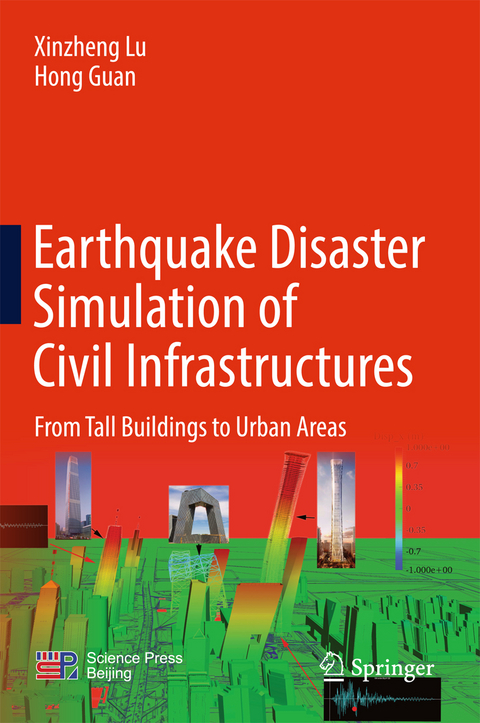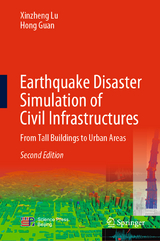
Earthquake Disaster Simulation of Civil Infrastructures
Springer Verlag, Singapore
978-981-10-3086-4 (ISBN)
- Titel erscheint in neuer Auflage
- Artikel merken
The high-fidelity computational model developed in this book has proven to be the only feasible option to date for earthquake-induced collapse simulation of supertall buildings that are higher than 500 m. More importantly, the proposed collapse simulation technique has already been successfully used in the design of some real-world supertall buildings, with significant savings of tens of thousands of tons of concrete and steel, whilst achieving a better seismic performance and safety.
The proposed novel solution for earthquake disaster simulation of urban areas using nonlinear multiple degree-of-freedom (MDOF) model and time-history analysis delivers several unique advantages: (1) true representation of the characteristic features of individual buildings and ground motions; (2) realistic visualization of earthquake scenarios, particularly dynamic shaking of buildings during earthquakes; (3) detailed prediction of seismic response and losses on each story of every building at any time period. The proposed earthquake disaster simulation technique has been successfully implemented in the seismic performance assessments and earthquake loss predictions of several central cities in China. The outcomes of the simulation as well as the feedback from the end users are encouraging, particularly for the government officials and/or administration department personnel with limited professional knowledge of earthquake engineering.
The book offers readers a systematic solution to earthquake disaster simulation of civil infrastructures. The application outcomes demonstrate a promising future of the proposed advanced techniques. The book provides a long-awaited guide for academics and graduate students involving in earthquake engineering research and teaching activities. It can also be used by structural engineers for seismic design of supertall buildings.
Prof. Xinzheng Lu obtained his BS and PhD degrees from Tsinghua University of China. He started his academic career in 2005 as an Assistant Professor at the same university. He was subsequently promoted to Associate Professor in December 2007, Head of the Institute of Disaster Prevention and Mitigation in 2010 and Full Professor in December 2012. His major research interests cover disaster prevention and mitigation of civil engineering structures. He participated in the emergency earthquake reconnaissance and structural retrofitting after Wenchuan (2008), Yushu (2010), Lushan (2013), Ludian (2014) and Nepal earthquakes (2015). Prof. Lu has published more than 200 papers in refereed journals and 11 books. His publications have received more than 8000 citations, including more than 600 citations in Web of Science, and more than 1600 citations in Scopus. One of his publications was listed by Essential Science Indicators as “Highly Cited Papers”. Twelve of his publications were listed as “Top 25 hottest articles” or “Most cited articles” of Elsevier or “Most viewed papers” of ASCE. The research outcomes of his work have been adopted by the Chinese national standards and applied in some engineering projects. Prof. Lu has received several important awards including the Young Scholarship of Chang Jiang Scholars Program of Ministry of Education of China (2015), the Early-Mid-Career Research Leader Program of the Promotion Plan of Innovative Talent of Ministry of Science and Technology of China (2013), the National Natural Science Award of China (Second Prize, 2013), the Excellent Young Scientist Fund of National Natural Science Foundation of China (2012) and the National Outstanding Doctoral Thesis Notification (2007). He is also the Editor-in-Chief of the Engineering Mechanics journal of the China Society of Theoretical and Applied Mechanics. Prof. Hong Guan obtained her double BEng degrees in Civil Engineering and Computer Engineering from Tsinghua University, China, her MEng degree in Structural Engineering from the Asian Institute of Technology, and her PhD degree from Griffith University, Australia. She is Professor in Structural Engineering and Mechanics at Griffith University Gold Coast Campus. Her main research areas are structural engineering and computational mechanics with special interests in finite element modelling and failure/collapse analysis of concrete structures, bridge deterioration modelling, application of finite element method in dental implant research and structural topology optimisation. She has co-authored one edited conference proceedings, and published over 100 peer-reviewed journal articles and over 120 refereed conference papers. Her publications have received more than 600 citations in Scopus. She has received numerous teaching awards including ALTC Citations for Outstanding Contributions to Student Learning from the Australian Learning & Teaching Council. She also received a “2011 Excellence Award for Innovation” from the Institute of Public Works Engineering Australia, Queensland Division (IPWEAQ), National Awards for Local Governments with a Commendation in the Category of Asset and Financial Management (2012), and Griffith Science, Engineering, Environment & Technology Pro Vice Chancellor’s Excellence Award of a Research Group (2012). She is a member of Engineers Australia, Australian Network on Structural Health Monitoring, Australian Association for Engineering Education, Queensland Chinese Association of Scientists and Engineers, Australian Steel Institute, and Women in Technology, Queensland, Australia.
Introduction.- High fidelity computational models for seismic simulation of tall buildings.- High performance computing and visualization for seismic simulation of tall buildings.- Seismic disaster simulation of typical super tall buildings.- Engineering application of seismic disaster simulation of supertall buildings.- Comparison of the seismic design and performance of tall buildings in China and USA.- Nonlinear MDOF models for seismic simulation of urban buildings.- Visualization of urban building seismic simulation.- High performance computing for urban building seismic simulation.- Seismic disaster simulation of typical urban areas.- Earthquake loss prediction for typical urban areas.
| Erscheinungsdatum | 10.01.2017 |
|---|---|
| Zusatzinfo | 296 Illustrations, color; 41 Illustrations, black and white; XVI, 440 p. 337 illus., 296 illus. in color. |
| Verlagsort | Singapore |
| Sprache | englisch |
| Maße | 155 x 235 mm |
| Gewicht | 8041 g |
| Themenwelt | Informatik ► Grafik / Design ► Digitale Bildverarbeitung |
| Mathematik / Informatik ► Informatik ► Theorie / Studium | |
| Naturwissenschaften ► Biologie ► Ökologie / Naturschutz | |
| Technik ► Bauwesen | |
| Schlagworte | Collapse Simulation • CPU/GPU High Performance Computing • High-fidelity Visualization • Performance-based Seismic Design • Resilience of Buildings and Communities • Seismic Damage Simulation • Tall and Supertall Buildings |
| ISBN-10 | 981-10-3086-3 / 9811030863 |
| ISBN-13 | 978-981-10-3086-4 / 9789811030864 |
| Zustand | Neuware |
| Haben Sie eine Frage zum Produkt? |
aus dem Bereich



